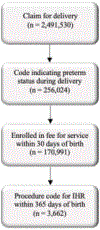Costs and recurrence of inguinal hernia repair in premature infants during neonatal admission
- PMID: 36529566
- PMCID: PMC10243490
- DOI: 10.1016/j.jpedsurg.2022.10.006
Costs and recurrence of inguinal hernia repair in premature infants during neonatal admission
Abstract
Background: Timing of inguinal hernia repair (IHR) in premature infants remains variable, yet the impact of IHR timing on procedure costs and recurrence is unclear. We sought to compare cost and recurrence rates of IHR in premature infants based on timing of repair.
Methods: We performed a retrospective cohort study using MarketScan insurance claims data from 2007 to 2018 to evaluate IHR occurring within 365 days of birth in preterm infants (gestational age [GA]<37 weeks at birth). Patients were stratified based on timing of IHR: those occurring during and after neonatal discharge. Hernia recurrences within one year following IHR were identified. Patient demographic characteristics and costs were compared between groups. Time to recurrence and cumulative recurrence hazards were estimated using Kaplan Meier analysis and Cox proportional hazards regression.
Results: We identified 3,662 preterm infants with IHR within 365 days of birth; 1,054(28.8%) occurred early. Infants with IHR during NICU stay were more likely to have GA at birth≤32 weeks (74.7% vs. 37.2%; p<0.01) and birthweight<1500 g (83.0% vs. 40.3%; p<0.01) compared to post-NICU IHR. The hernia recurrence rate was higher and total procedure costs lower in early IHR. Early IHR (HR:1.86, 95% CI: 1.56-2.22), incarcerated/strangulated hernia (HR:1.86, 95% CI:1.49-2.32), GA≤32 weeks (HR: 1.40, 95% CI: 1.19-1.65), and congenital anomalies (HR: 1.32, 95% CI: 1.12-1.57) were predictors of hernia recurrence.
Conclusion: Using insurance claims data, IHR performed during initial neonatal admission was associated with lower cost, but higher recurrence rate, when compared to delayed repairs in preterm infants.
Type of study: Retrospective study LEVEL OF EVIDENCE: Level III.
Keywords: Cost analysis; Hernia repair; Inguinal hernia; Neonatal intensive care unit; Prematurity.
Copyright © 2022. Published by Elsevier Inc.
Figures
References
-
- Khan FA, Zeidan N, Larson SD, Taylor JA, Islam S. Inguinal hernias in premature neonates: exploring optimal timing for repair. Pediatr Surg Int 2018;34(11):1157–61. - PubMed
-
- Kumar VH, Clive J, Rosenkrantz TS, Bourque MD, Hussain N. Inguinal hernia in preterm infants (≤32-Week Gestation). Pediatr Surg Int 2002;18,147–152. - PubMed
-
- Peevy KJ, Speed FA, Hoff CJ. Epidemiology of inguinal hernia in preterm neonates. Pediatrics. 1986;77(2):246–247. - PubMed
-
- Fu YW, Pan ML, Hsu YJ, Chin TW. A nationwide survey of incidence rates and risk factors of inguinal hernia in preterm children. Pediatr Surg Int 2018;34(1):91–5. - PubMed
-
- Lautz TB, Raval MV, Reynolds M. Does timing matter? A national perspective on the risk of incarceration in premature neonates with inguinal hernia. J Pediatr 2011;158(4):573–7. - PubMed
MeSH terms
Grants and funding
LinkOut - more resources
Full Text Sources
Medical
Research Materials



